A Systematic Literature Review of Vehicle Routing Problems with Time Windows
Abstract
1. Introduction
2. Method
2.1. Determine Research Questions and Objectives
- What are the major challenges and issues faced by VRPTW?
- What are the existing algorithms and solution methods for VRPTW?
- What are the evaluation metrics used to assess the performance of VRPTW algorithms?
- What are the shortcomings and deficiencies of the existing algorithms?
- What are the future research directions and trends in VRPTW?
- To provide a comprehensive analysis of the main challenges and issues faced by VRPTW.
- To review and summarize the existing algorithms and solution methods for VRPTW.
- To identify and analyze the evaluation metrics used to assess the performance of VRPTW algorithms.
- To highlight the shortcomings and deficiencies of the existing algorithms and propose potential improvements.
- To identify and discuss the future research directions and trends in VRPTW.
2.2. Determine Search Strategy and Selection Criteria
2.3. Perform Screening and Data Extraction
2.4. Perform Data Synthesis and Analysis
2.5. Identifying Future Research Directions
3. Result
3.1. Answering Research Question No. 1: What Are the Major Challenges and Issues Faced by VRPTW?
3.2. Answering Research Question No. 2: What Are the Existing Algorithms and Solution Methods for VRPTW?
3.3. Answering Research Question No. 3: What Are the Evaluation Metrics Used to Assess the Performance of VRPTW Algorithms?
3.4. Answering Research Question No. 4: What Are the Shortcomings and Deficiencies of the Existing Algorithms?
3.5. Answering Research Question No. 5: What Are the Future Research Directions and Trends in VRPTW?
4. Conclusions
5. Limitation
Supplementary Materials
Author Contributions
Funding
Institutional Review Board Statement
Informed Consent Statement
Data Availability Statement
Conflicts of Interest
References
- Solomon, M.M. Algorithms for the vehicle routing and scheduling problems with time window constraints. Oper. Res. 1987, 35, 254–265. [Google Scholar] [CrossRef]
- Agrawal, P.; Kaur, G.; Kolekar, S.S. Investigation on biomedical waste management of hospitals using cohort intelligence algorithm. Soft Comput. Lett. 2021, 3, 100008. [Google Scholar] [CrossRef]
- Jiang, P.; Men, J.; Xu, H.; Zheng, S.; Kong, Y.; Zhang, L. A Variable Neighborhood Search-Based Hybrid Multiobjective Evolutionary Algorithm for HazMat Heterogeneous Vehicle Routing Problem With Time Windows. IEEE Syst. J. 2020, 14, 4344–4355. [Google Scholar] [CrossRef]
- Dekhici, L.; Redjem, R.; Belkadi, K.; Mhamedi, A.E. Discretization of the firefly algorithm for home care. Can. J. Electr. Comput. Eng. 2019, 42, 20–26. [Google Scholar] [CrossRef]
- Riazi, S.; Wigström, O.; Bengtsson, K.; Lennartson, B. A column generation-based gossip algorithm for home healthcare routing and scheduling problems. IEEE Trans. Autom. Sci. Eng. 2019, 16, 127–137. [Google Scholar] [CrossRef]
- Wu, Y.; Zheng, B.; Zhou, X.L. A disruption recovery model for time-dependent vehicle routing problem with time windows in delivering perishable goods. IEEE Access 2020, 8, 189614–189631. [Google Scholar] [CrossRef]
- Zhang, S.Q.; Mu, D.; Wang, C. A Solution for the Full-Load Collection Vehicle Routing Problem With Multiple Trips and Demands: An Application in Beijing. IEEE Access 2020, 8, 89381–89394. [Google Scholar] [CrossRef]
- Zhou, F.L.; He, Y.D.; Zhou, L. Last Mile Delivery With Stochastic Travel Times Considering Dual Services. IEEE Access 2019, 7, 159013–159021. [Google Scholar] [CrossRef]
- Liu, R.S.; Wang, N. Data-Driven Bus Route Optimization Algorithm Under Sudden Interruption of Public Transport. IEEE Access 2022, 10, 5250–5263. [Google Scholar] [CrossRef]
- Li, X.; Gao, J.; Wang, C.; Huang, X.; Nie, Y. Ride-Sharing Matching Under Travel Time Uncertainty Through Data-Driven Robust Optimization. IEEE Access 2022, 10, 116931–116941. [Google Scholar] [CrossRef]
- Sun, Q.; Chien, S.; Hu, D.; Chen, G.; Jiang, R.-S. Optimizing Multi-Terminal Customized Bus Service With Mixed Fleet. IEEE Access 2020, 8, 156456–156469. [Google Scholar] [CrossRef]
- Expósito, A.; Brito, J.; Moreno, J.A.; Expósito-Izquierdo, C. Quality of service objectives for vehicle routing problem with time windows. Appl. Soft Comput. 2019, 84, 105707. [Google Scholar] [CrossRef]
- Goel, R.; Maini, R.; Bansal, S. Vehicle routing problem with time windows having stochastic customers demands and stochastic service times: Modelling and solution. J. Comput. Sci. 2019, 34, 1–10. [Google Scholar] [CrossRef]
- Hoogeboom, M.; Dullaert, W. Vehicle routing with arrival time diversification. Eur. J. Oper. Res. 2019, 275, 93–107. [Google Scholar] [CrossRef]
- Song, M.-X.; Li, J.-Q.; Han, Y.Q.; Han, Y.-Y.; Liu, L.-L.; Sun, Q. Metaheuristics for solving the vehicle routing problem with the time windows and energy consumption in cold chain logistics. Appl. Soft Comput. 2020, 95, 106561. [Google Scholar] [CrossRef]
- Fontaine, P. The vehicle routing problem with load-dependent travel times for cargo bicycles. Eur. J. Oper. Res. 2022, 300, 1005–1016. [Google Scholar] [CrossRef]
- Perboli, G.; Rosano, M.; Wei, Q. A Simulation-Optimization Approach for the Management of the On-Demand Parcel Delivery in Sharing Economy. IEEE Trans. Intell. Transp. Syst. 2022, 23, 10570–10582. [Google Scholar] [CrossRef]
- Miguel, F.; Frutos, M.; Tohmé, F.; Babey, M.M. A Decision Support Tool for Urban Freight Transport Planning Based on a Multi-Objective Evolutionary Algorithm. IEEE Access 2019, 7, 156707–156721. [Google Scholar] [CrossRef]
- Chen, B.; Qu, R.; Bai, R.; Laesanklang, W. A hyper-heuristic with two guidance indicators for bi-objective mixed-shift vehicle routing problem with time windows. Appl. Intell. 2018, 48, 4937–4959. [Google Scholar] [CrossRef]
- Ali, O.; Cote, J.F.; Coelho, L.C. Models and algorithms for the delivery and installation routing problem. Eur. J. Oper. Res. 2021, 291, 162–177. [Google Scholar] [CrossRef]
- Chaieb, M.; Ben, D. Sassi, Measuring and evaluating the Home Health Care Scheduling Problem with Simultaneous Pick-up and Delivery with Time Window using a Tabu Search metaheuristic solution. Appl. Soft Comput. 2021, 113, 107957. [Google Scholar] [CrossRef]
- Li, J.; Li, T.; Yu, Y.; Zhang, Z.; Pardalos, P.M.; Zhang, Y.; Ma, Y. Discrete firefly algorithm with compound neighborhoods for asymmetric multi-depot vehicle routing problem in the maintenance of farm machinery. Appl. Soft Comput. 2019, 81, 105460. [Google Scholar] [CrossRef]
- Macrina, G.; Laporte, G.; Guerriero, F.; Pugliese, L.D.P. An energy-efficient green-vehicle routing problem with mixed vehicle fleet, partial battery recharging and time windows. Eur. J. Oper. Res. 2019, 276, 971–982. [Google Scholar] [CrossRef]
- Molina, J.C.; Salmero, J.L.; Eguia, I.; Racero, J. The heterogeneous vehicle routing problem with time windows and a limited number of resources. Eng. Appl. Artif. Intell. 2020, 94, 103745. [Google Scholar] [CrossRef]
- Goel, R.; Maini, R. A hybrid of ant colony and firefly algorithms (HAFA) for solving vehicle routing problems. J. Comput. Sci. 2018, 25, 28–37. [Google Scholar] [CrossRef]
- Miranda, D.M.; Branke, J.; Conceicao, S.V. Algorithms for the multi-objective vehicle routing problem with hard time windows and stochastic travel time and service time. Appl. Soft Comput. 2018, 70, 66–79. [Google Scholar] [CrossRef]
- Shi, Y.; Zhou, Y.; Boudouh, T.; Grunder, O. A lexicographic-based two-stage algorithm for vehicle routing problem with simultaneous pickup-delivery and time window. Eng. Appl. Artif. Intell. 2020, 95, 103901. [Google Scholar] [CrossRef]
- Yesodha, R.; Amudha, T. A bio-inspired approach: Firefly algorithm for Multi-Depot Vehicle Routing Problem with Time Windows. Comput. Commun. 2022, 190, 48–56. [Google Scholar] [CrossRef]
- Sitek, P.; Wikarek, J.; Rutczyńska-Wdowiak, K.; Bocewicz, G.; Banaszak, Z. Optimization of capacitated vehicle routing problem with alternative delivery, pick-up and time windows: A modified hybrid approach. Neurocomputing 2021, 423, 670–678. [Google Scholar] [CrossRef]
- Zheng, J. A Vehicle Routing Problem Model With Multiple Fuzzy Windows Based on Time-Varying Traffic Flow. IEEE Access 2020, 8, 39439–39444. [Google Scholar] [CrossRef]
- Zhang, H.; Wang, Z.; Tang, M.; Lv, X.; Luo, H.; Liu, Y. Dynamic Memory Memetic Algorithm for VRPPD With Multiple Arrival Time and Traffic Congestion Constraints. IEEE Access 2020, 8, 167537–167554. [Google Scholar] [CrossRef]
- Yu, V.F.; Susanto, H.; Jodiawan, P.; Ho, T.-W.; Lin, S.-W.; Huang, Y.-T. A Simulated Annealing Algorithm for the Vehicle Routing Problem With Parcel Lockers. IEEE Access 2022, 10, 20764–20782. [Google Scholar] [CrossRef]
- Lan, Y.-L.; Liu, F.; Ng, W.W.Y.; Zhang, J.; Gui, M. Decomposition Based Multi-Objective Variable Neighborhood Descent Algorithm for Logistics Dispatching. IEEE Trans. Emerg. Top. Comput. Intell. 2021, 5, 826–839. [Google Scholar] [CrossRef]
- Zhu, Y.F.; Lee, K.Y.; Wang, Y.H. Adaptive Elitist Genetic Algorithm With Improved Neighbor Routing Initialization for Electric Vehicle Routing Problems. IEEE Access 2021, 9, 16661–16671. [Google Scholar] [CrossRef]
- Lu, D.; Gzara, F. The robust vehicle routing problem with time windows: Solution by branch and price and cut. Eur. J. Oper. Res. 2019, 275, 925–938. [Google Scholar] [CrossRef]
- Li, G.M.; Li, J.H. An Improved Tabu Search Algorithm for the Stochastic Vehicle Routing Problem With Soft Time Windows. IEEE Access 2020, 8, 158115–158124. [Google Scholar] [CrossRef]
- Pan, B.B.; Zhang, Z.Z.; Lim, A. Multi-trip time-dependent vehicle routing problem with time windows. Eur. J. Oper. Res. 2021, 291, 218–231. [Google Scholar] [CrossRef]
- Wang, Y.; Li, Q.; Guan, X.; Fan, J.; Xu, M.; Wang, H. Collaborative multi-depot pickup and delivery vehicle routing problem with split loads and time windows. Knowl. Based Syst. 2021, 231, 107412. [Google Scholar] [CrossRef]
- Wang, J.H.; Weng, T.Y.; Zhang, Q.F. A Two-Stage Multiobjective Evolutionary Algorithm for Multiobjective Multidepot Vehicle Routing Problem With Time Windows. IEEE Trans. Cybern. 2019, 49, 2467–2478. [Google Scholar] [CrossRef]
- Wu, L.; He, Z.; Chen, Y.; Wu, D.; Cui, J. Brainstorming-Based Ant Colony optimization for Vehicle Routine With Soft Time Windows. IEEE Access 2019, 7, 19643–19652. [Google Scholar] [CrossRef]
- Sun, B.; Yang, Y.; Shi, J.; Zheng, L. Dynamic Pick-Up and Delivery Optimization With Multiple Dynamic Events in Real-World Environment. IEEE Access 2019, 7, 146209–146220. [Google Scholar] [CrossRef]
- Wang, J.; Sun, Y.; Zhang, Z.; Gao, S. Solving multitrip pickup and delivery problem with time windows and manpower planning using multiobjective algorithms. IEEE/CAA J. Autom. 2020, 7, 1134–1153. [Google Scholar] [CrossRef]
- He, M.; Wei, Z.; Wu, X.; Peng, Y. An Adaptive Variable Neighborhood Search Ant Colony Algorithm for Vehicle Routing Problem With Soft Time Windows. IEEE Access 2021, 9, 21258–21266. [Google Scholar] [CrossRef]
- Shen, Y.; Liu, M.; Yang, J.; Shi, Y.; Middendorf, M. A Hybrid Swarm Intelligence Algorithm for Vehicle Routing Problem With Time Windows. IEEE Access 2020, 8, 93882–93893. [Google Scholar] [CrossRef]
- Zhang, J.T.; Yang, F.X.; Weng, X. An Evolutionary Scatter Search Particle Swarm Optimization Algorithm for the Vehicle Routing Problem With Time Windows. IEEE Access 2018, 6, 63468–63485. [Google Scholar] [CrossRef]
- Khoo, T.-S.; Mohammad, B.B.; Wong, V.-H.; Tay, Y.-H.; Nair, M. A Two-Phase Distributed Ruin-and-Recreate Genetic Algorithm for Solving the Vehicle Routing Problem With Time Windows. IEEE Access 2020, 8, 169851–169871. [Google Scholar] [CrossRef]
- Liu, M.; Song, Q.; Zhao, Q.; Li, L.; Yang, Z.; Zhang, Y. A Hybrid BSO-ACO for Dynamic Vehicle Routing Problem on Real-World Road Networks. IEEE Access 2022, 10, 118302–118312. [Google Scholar] [CrossRef]
- Mao, H.; Shi, J.; Zhou, Y.; Zhang, G. The Electric Vehicle Routing Problem With Time Windows and Multiple Recharging Options. IEEE Access 2020, 8, 114864–114875. [Google Scholar] [CrossRef]
- Yu, N.; Qian, B.; Hu, R.; Chen, Y.; Wang, L. Solving open vehicle problem with time window by hybrid column generation algorithm. J. Syst. Eng. Electron. 2022, 33, 997–1009. [Google Scholar] [CrossRef]
- Lin, B.; Ghaddar, B.; Nathwani, J. Deep Reinforcement Learning for the Electric Vehicle Routing Problem With Time Windows. IEEE Trans. Intell. Transp. Syst. 2022, 23, 11528–11538. [Google Scholar] [CrossRef]
- Tilk, C.; Drexl, M.; Irnich, S. Nested branch-and-price-and-cut for vehicle routing problems with multiple resource interdependencies. Eur. J. Oper. Res. 2019, 276, 549–565. [Google Scholar] [CrossRef]
- Deng, Y.; Zhu, W.; Li, H.; Zheng, Y. Multi-type ant system algorithm for the time dependent vehicle routing problem with time windows. J. Syst. Eng. Electron. 2018, 29, 625–638. [Google Scholar]
- Liu, R.; Jiang, Z.B. A hybrid large-neighborhood search algorithm for the cumulative capacitated vehicle routing problem with time-window constraints. Appl. Soft Comput. 2019, 80, 18–30. [Google Scholar] [CrossRef]
- Jie, K.W.; Liu, S.Y.; Sun, X.J. A hybrid algorithm for time-dependent vehicle routing problem with soft time windows and stochastic factors. Eng. Appl. Artif. Intell. 2022, 109, 104606. [Google Scholar] [CrossRef]
- Chen, C.; Demir, E.; Huang, Y. An adaptive large neighborhood search heuristic for the vehicle routing problem with time windows and delivery robots. Eur. J. Oper. Res. 2021, 294, 1164–1180. [Google Scholar] [CrossRef]
- Ciancio, C.; Lagana, D.; Vocaturo, F. Branch-price-and-cut for the Mixed Capacitated General Routing Problem with Time Windows. Eur. J. Oper. Res. 2018, 267, 187–199. [Google Scholar] [CrossRef]
- Gmira, M.; Gendreau, M.; Lodi, A.; Potvin, J.-Y. Tabu search for the time-dependent vehicle routing problem with time windows on a road network. Eur. J. Oper. Res. 2021, 288, 129–140. [Google Scholar] [CrossRef]
- Lagos, C.; Guerrero, G.; Cabrera, E.; Moltedo, A.; Johnson, F.; Paredes, F. An improved Particle Swarm Optimization Algorithm for the VRP with Simultaneous Pickup and Delivery and Time Windows. IEEE Lat. Am. Trans. 2018, 16, 1732–1740. [Google Scholar] [CrossRef]
- Page, M.J.; McKenzie, J.E.; Bossuyt, P.M.; Boutron, I.; Hoffmann, T.C.; Mulrow, C.D.; Shamseer, L.; Tetzlaff, J.M.; Akl, E.A.; Brennan, S.E.; et al. The PRISMA 2020 statement: An updated guideline for reporting systematic reviews. Rev. Panam. Salud Publica-Pan Am. J. Public Health 2022, 46, e112. [Google Scholar]
- Kitchenham, B.; Charters, S. Guidelines for Performing Systematic Literature Reviews in Software Engineering; Technical Report EBSE 2007-001, Keele University and Durham University Joint Report. 2007. Available online: https://www.elsevier.com/__data/promis_misc/525444systematicreviewsguide.pdf (accessed on 20 June 2023).
- Jiang, G.; Lam, S.-K.; Ning, F.; He, P.; Xie, J. Peak-Hour Vehicle Routing for First-Mile Transportation: Problem Formulation and Algorithms. IEEE Trans. Intell. Transp. Syst. 2020, 21, 3308–3321. [Google Scholar] [CrossRef]
- Paul, A.; Kumar, R.S.; Rout, C.; Goswami, A. A bi-objective two-echelon pollution routing problem with simultaneous pickup and delivery under multiple time windows constraint. OpSearch 2021, 58, 962–993. [Google Scholar] [CrossRef]
- Duan, J.H.; He, Z.A.; Yen, G.G. Robust Multiobjective Optimization for Vehicle Routing Problem With Time Windows. IEEE Trans. Cybern. 2022, 52, 8300–8314. [Google Scholar] [CrossRef] [PubMed]
- Raeesi, R.; Zografos, K.G. Coordinated routing of electric commercial vehicles with intra-route recharging and en-route battery swapping. Eur. J. Oper. Res. 2022, 301, 82–109. [Google Scholar] [CrossRef]
- Reil, S.; Bortfeldt, A.; Monch, L. Heuristics for vehicle routing problems with backhauls, time windows, and 3D loading constraints. Eur. J. Oper. Res. 2018, 266, 877–894. [Google Scholar] [CrossRef]
- Shen, Y.; Yu, L.; Li, J. Robust Electric Vehicle Routing Problem with Time Windows under Demand Uncertainty and Weight-Related Energy Consumption. Complex Syst. Model. Simul. 2022, 2, 18–34. [Google Scholar] [CrossRef]
- Liu, C.; Kou, G.; Zhou, X.; Peng, Y.; Sheng, H.; Alsaadi, F.E. Time-dependent vehicle routing problem with time windows of city logistics with a congestion avoidance approach. Knowl. Based Syst. 2020, 188, 104813. [Google Scholar] [CrossRef]
- Shen, Y.D.; Peng, L.W.; Li, J. An improved estimation of distribution algorithm for multi-compartment electric vehicle routing problem. J. Syst. Eng. Electron. 2021, 32, 365–379. [Google Scholar]
- Yan, X.; Xiao, B.; Xiao, Y.; Zhao, Z.; Ma, L.; Wang, N. Skill vehicle routing problem with time windows considering dynamic service times and time-skill-dependent costs. IEEE Access 2019, 7, 77208–77221. [Google Scholar] [CrossRef]
- Ahamed, T.; Zou, B.; Farazi, N.P.; Tulabandhula, T. Deep reinforcement learning for crowdsourced urban delivery. Transp. Res. B Methodol. 2021, 152, 227–257. [Google Scholar] [CrossRef]
- Voigt, S.; Frank, M.; Fontaine, P.; Kuhn, H. The Vehicle Routing Problem with Availability Profiles. Transp. Sci. 2022, 57, 531–551. [Google Scholar] [CrossRef]
- Sahin, M.K.; Yamana, H. A Branch and Price Algorithm for the Heterogeneous Fleet Multi-Depot Multi-Trip Vehicle Routing Problem with Time Windows. Transp. Sci. 2022, 56, 1409–1722. [Google Scholar] [CrossRef]
- Marques, G.; Sadykov, R.; Dupas, R.; Deschamps, J.-C. A Branch-Cut-and-Price Approach for the Single-Trip and Multi-Trip Two-Echelon Vehicle Routing Problem with Time Windows. Transp. Sci. 2022, 56, 1598–1617. [Google Scholar] [CrossRef]
- Froger, A.; Jabali, O.; Mendoza, J.E.; Laporte, G. The Electric Vehicle Routing Problem with Capacitated Charging Stations. Transp. Sci. 2022, 56, 460–482. [Google Scholar] [CrossRef]
- Montoya, A.; Gueret, C.; Mendoza, J.E.; Villegas, J.G. The electric vehicle routing problem with nonlinear charging function. Transp. Res. B Methodol. 2017, 103, 87–110. [Google Scholar] [CrossRef]
- Zhan, X.; Szeto, W.Y.; Wang, Y. The ride-hailing sharing problem with parcel transportation. Transp. Res. E Logist. Transp. Rev. 2023, 172, 103073. [Google Scholar] [CrossRef]
- Guo, Q.; Ban, X.J. A multi-scale control framework for urban traffic control with connected and automated vehicles. Transp. Res. B Methodol. 2023, 175, 102787. [Google Scholar] [CrossRef]
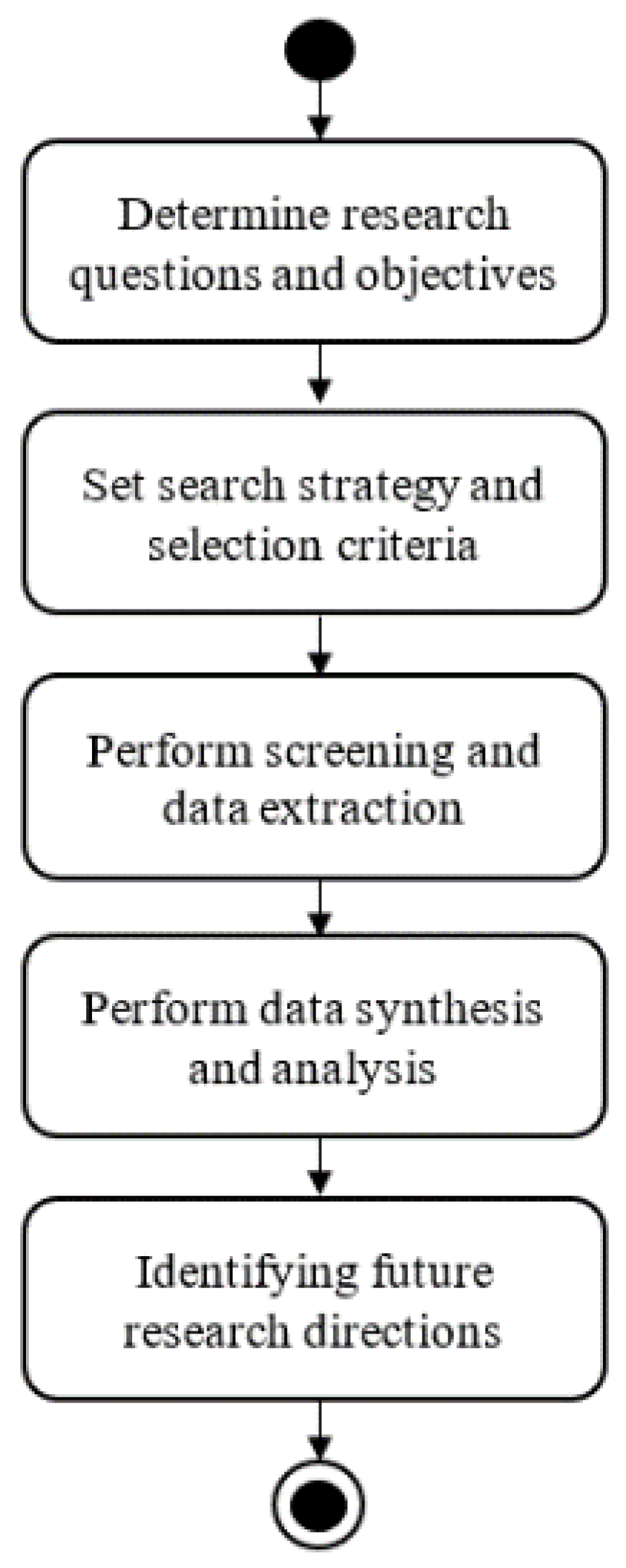
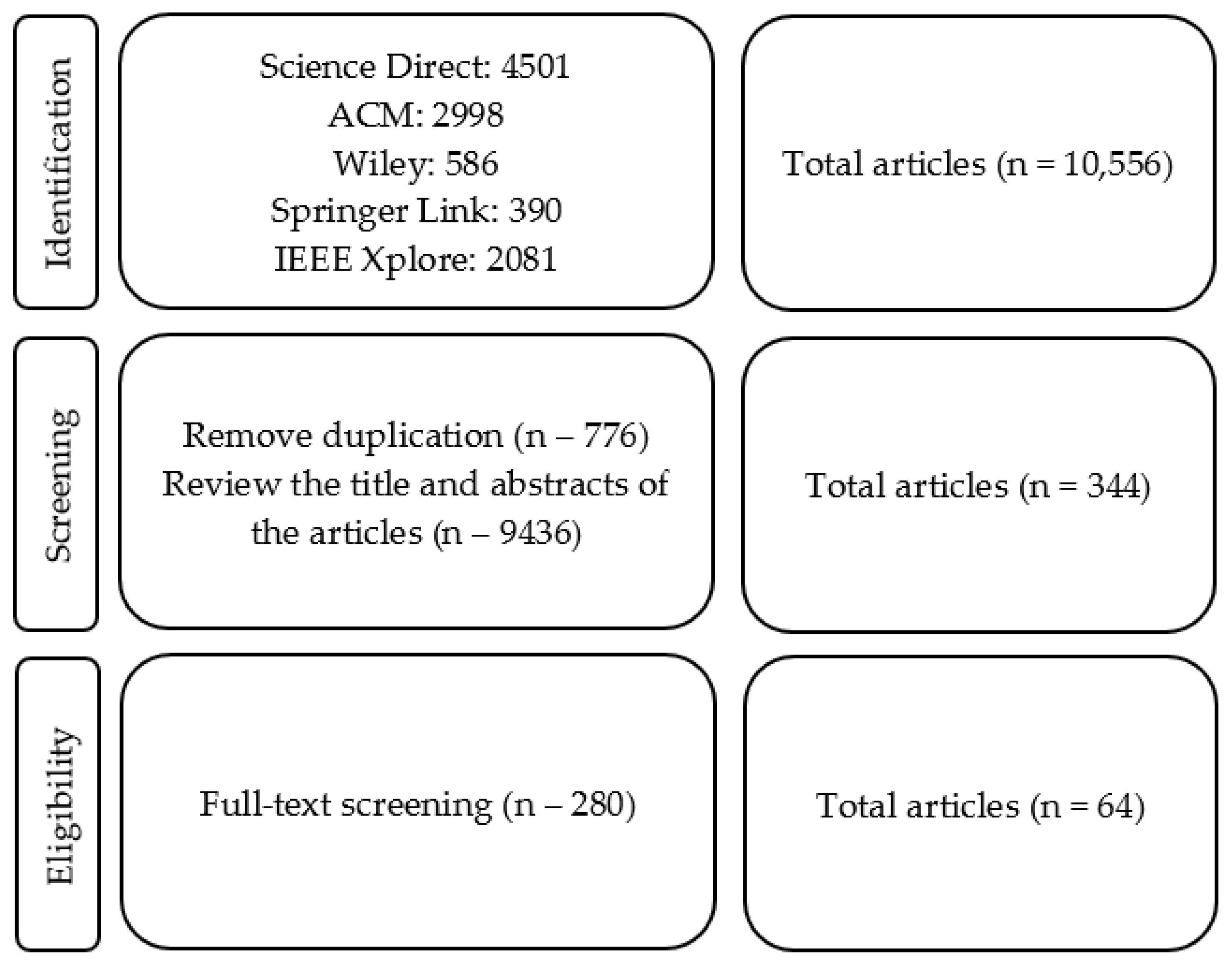
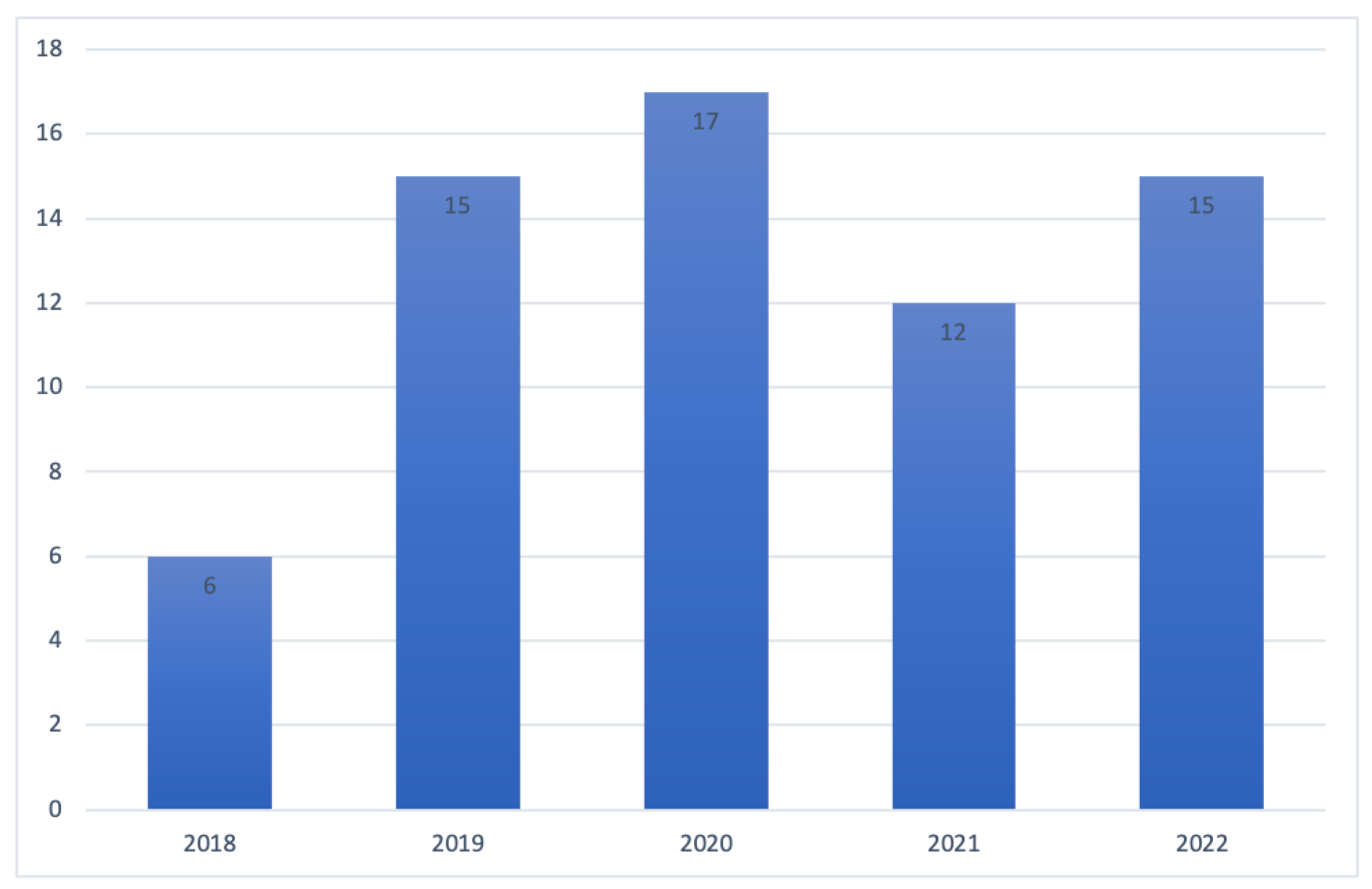
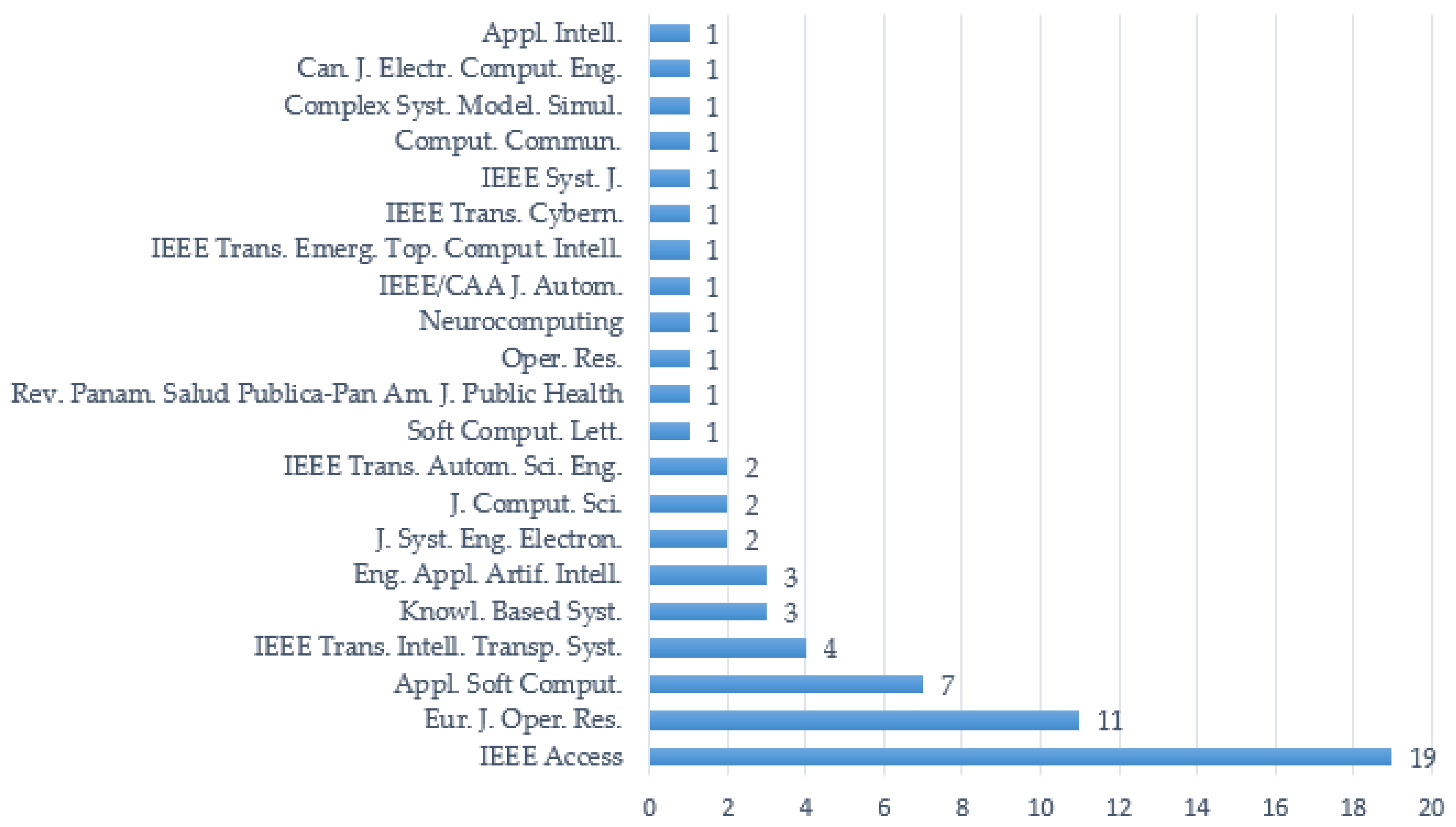
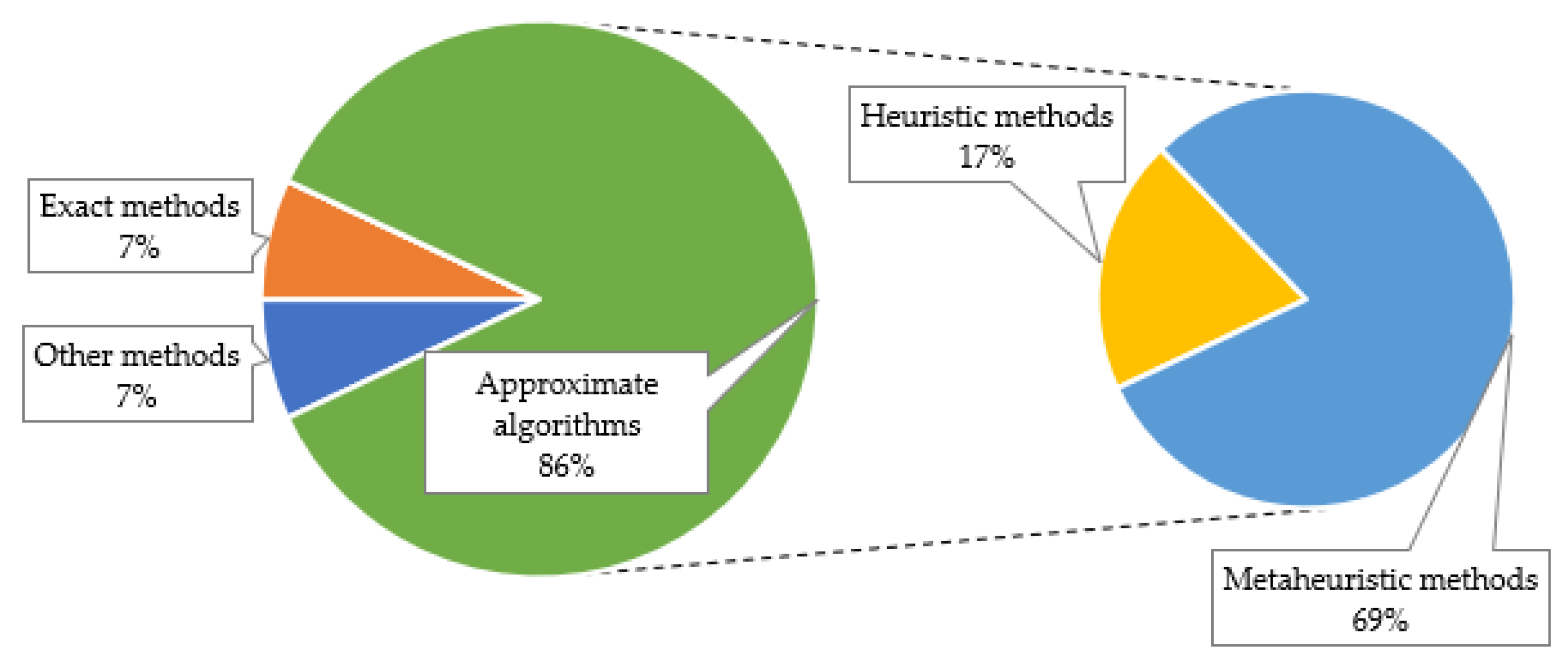
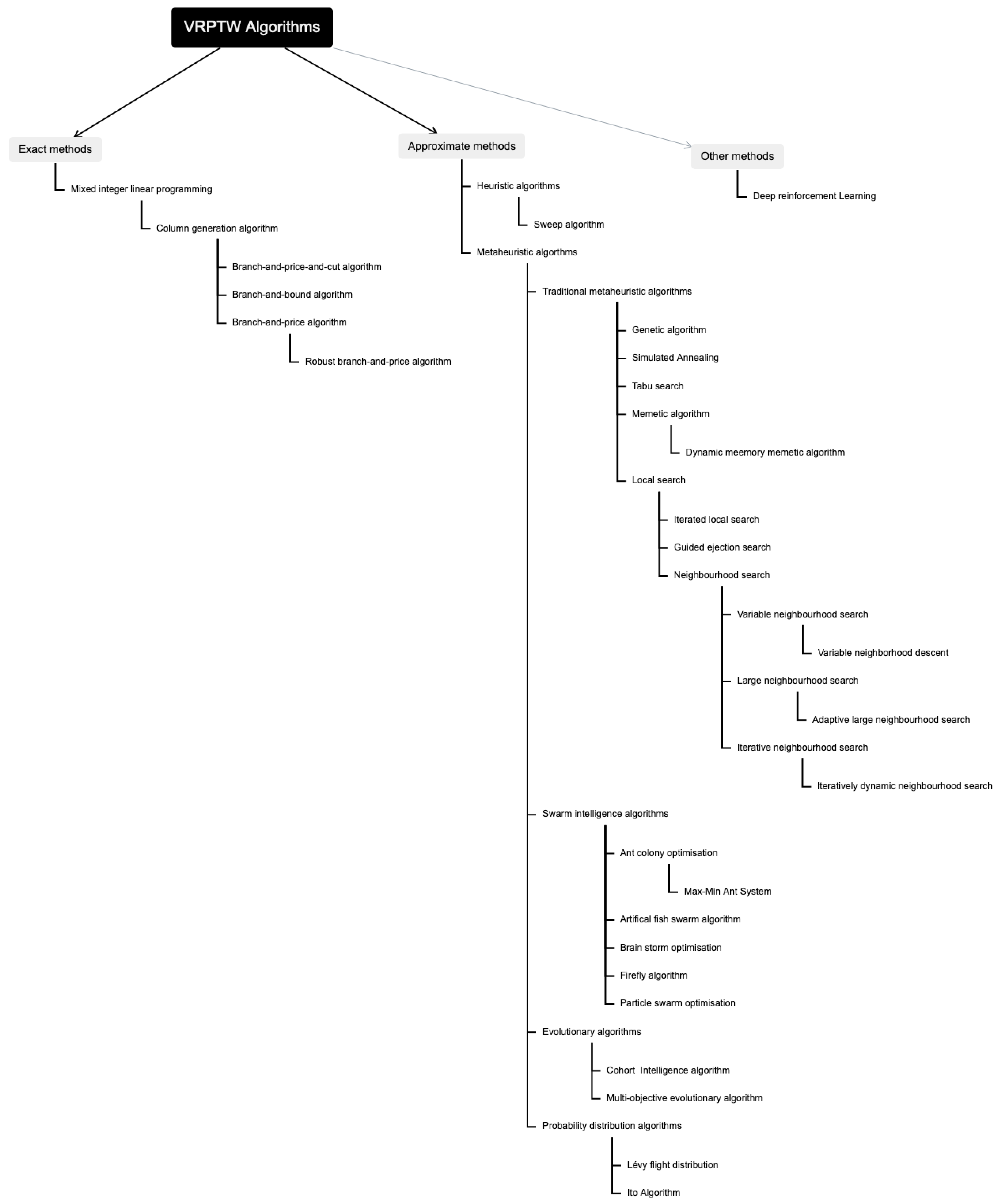
| Database | URL |
|---|---|
| Science Direct | https://www.sciencedirect.com/ (accessed on 30 June 2023) |
| ACM | https://dl.acm.org/ (accessed on 30 June 2023) |
| Wiley | https://onlinelibrary.wiley.com/ (accessed on 30 June 2023) |
| Springer Link IEEE Xplore | https://link.springer.com/ (accessed on 30 June 2023) https://ieeexplore.ieee.org/ (accessed on 30 June 2023) |
| Inclusion Criteria | Exclusion Criteria |
|---|---|
| 1. Articles that are peer-reviewed original articles | 1. Studies that do not validate the proposed method or algorithm |
| 2. Articles that have a proposed approach for VRPTW | 2. Studies offering unclear results or findings |
| 3. Articles that solve the problem of VRPTW and related variants | 3. Short papers, posters, short communications, and patents |
| 4. Articles that can access full-text content | 4. Duplicated studies (by title or content) |
| 5. Studies written in the English language | 5. Articles that were published other than 1 January 2018 to 31 December 2022 |
| Journal | Publisher | Articles | Count |
|---|---|---|---|
| Applied Intelligence | Springer | [46] | 1 |
| Canadian Journal of Electrical and Computer Engineering-Revure Canadienne De Genie Electrique Et Informatique | IEEE | [25] | 1 |
| Complex System Modeling and Simulation | IEEE | [57] | 1 |
| Computer Communications | Elsevier | [5] | 1 |
| Ieee Systems Journal | IEEE | [61] | 1 |
| Ieee Transactions on Cybernetics | IEEE | [18,48] | 2 |
| Ieee Transactions on Emerging Topics in Computational Intelligence | IEEE | [10] | 1 |
| Ieee-Caa Journal of Automatica Sinica | IEEE | [21] | 1 |
| Neurocomputing | Elsevier | [6] | 1 |
| Revista Panamericana De Salud Publica-Pan American Journal of Public Health | PAHO | [62] | 1 |
| Soft Computing Letters | Elsevier | [63] | 1 |
| Ieee Transactions on Automation Science and Engineering | IEEE | [64] | 1 |
| Ieee Latin America Transactions | IEEE | [41] | 1 |
| Journal of Computational Science | Elsevier | [1,65] | 2 |
| Journal of Systems Engineering and Electronics | IEEE | [30,33] | 2 |
| Engineering Applications of Artificial Intelligence | Elsevier | [3,15,35] | 3 |
| Knowledge-Based Systems | Elsevier | [17,58] | 3 |
| Ieee Transactions on Intelligent Transportation Systems | IEEE | [31,44,66] | 3 |
| Applied Soft Computing | Elsevier | [2,4,13,34,43,54] | 6 |
| European Journal of Operational Research | Elsevier | [12,16,32,36,37,38,39,42,49,51,55,56] | 12 |
| Ieee Access | IEEE | [7,8,9,11,14,19,20,22,23,24,26,27,28,29,40,47,50,52,53,67] | 19 |
| Article | C1 | C2 | C3 | C4 | C5 | C6 | C7 | C8 | C9 | C10 |
|---|---|---|---|---|---|---|---|---|---|---|
| Chen et al. (2018) [19] | * | * | * | * | ||||||
| Chen et al. (2021) [55] | * | * | * | * | * | * | ||||
| Ciancio et al. (2018) [56] | * | * | * | * | ||||||
| Gmira et al. (2021) [57] | * | * | * | * | ||||||
| Goel and Maini (2018) [25] | * | * | * | * | ||||||
| Goel et al. (2019) [13] | * | * | * | * | * | * | ||||
| Hoogeboom and Dullaert (2019) [14] | * | * | * | |||||||
| Jie et al. (2022) [54] | * | * | * | * | * | |||||
| Liu and Jiang (2019) [53] | * | * | * | * | ||||||
| Liu et al. (2020) [67] | * | * | * | * | ||||||
| Lu and Gzara (2019) [35] | * | * | * | |||||||
| Macrina et al. (2019) [23] | * | * | * | * | * | |||||
| Miranda et al. (2018) [26] | * | * | * | * | * | * | ||||
| Molina et al. (2020) [24] | * | * | * | * | ||||||
| Pan et al. (2021) [37] | * | * | * | * | ||||||
| Reil et al. (2018) [65] | * | * | * | * | * | |||||
| Shi et al. (2020) [27] | * | * | * | * | * | |||||
| Song et al. (2020) [15] | * | * | * | * | ||||||
| Wang et al. (2021) [38] | * | * | * | * | * | |||||
| Yesodha and Amudha (2022) [28] | * | * | * | * | * | |||||
| Exposito-Marquez et al. (2019) [12] | * | * | * | * | * | |||||
| Ali et al. (2021) [20] | * | * | ||||||||
| Fontaine (2022) [16] | * | * | ||||||||
| Sitek et al. (2022) [29] | * | * | * | |||||||
| Chaieb and Sassi (2021) [21] | * | * | * | |||||||
| Li et al. (2019) [22] | * | * | ||||||||
| Tilk et al. (2019) [51] | * | * | ||||||||
| Raeesi and Zografos (2021) [64] | * | * | ||||||||
| Agrawal et al. (2021) [2] | * | * | ||||||||
| Jiang et al. (2020) [3] | * | * | * | |||||||
| Lagos et al. (2018) [58] | * | * | ||||||||
| Zheng (2020) [30] | * | * | ||||||||
| Shen et al. (2020) [44] | * | |||||||||
| Jiang et al. (2020) [61] | * | * | ||||||||
| Duan et al. (2022) [63] | * | * | ||||||||
| Dekhici et al. (2019) [4] | * | * | ||||||||
| Deng et al. (2018) [52] | * | * | ||||||||
| Wang et al. (2019) [39] | * | * | ||||||||
| Wu et al. (2020) [6] | * | * | ||||||||
| Zhang et al. (2020) [31] | * | * | ||||||||
| Shen et al. (2022) [66] | * | * | * | |||||||
| Mao et al. (2020) [48] | * | * | ||||||||
| Shen et al. (2021) [68] | * | * | * | |||||||
| Yan et al. (2019) [69] | * | * | ||||||||
| He et al. (2021) [43] | * | |||||||||
| Li and Li (2020) [36] | * | |||||||||
| Wu et al. (2019) [40] | * | |||||||||
| Khoo et al. (2020) [46] | * | |||||||||
| Zhang et al. (2018) [45] | * | |||||||||
| Yu et al. (2022) [49] | * | |||||||||
| Lin et al. (2022) [50] | * | * | ||||||||
| Yu et al. (2022) [32] | * | |||||||||
| Liu et al. (2022) [47] | * | * | ||||||||
| Lan et al. (2020) [33] | * | * | ||||||||
| Riazi et al. (2019) [5] | * | |||||||||
| Zhang et al. (2020) [7] | * | * | ||||||||
| Zhu et al. (2021) [34] | * | * | ||||||||
| Sun et al. (2019) [41] | * | * | ||||||||
| Zhou et al. (2019) [8] | * | * | ||||||||
| Wang et al. (2020) [42] | * | * | * | |||||||
| Liu and Wang (2022) [9] | * | * | * | |||||||
| Perboli et al. (2021) [17] | * | * | ||||||||
| Li et al. (2022) [10] | * | * | ||||||||
| Miguel et al. (2019) [18] | * | * | * | * |
| Article | Citations |
|---|---|
| Goel & Maini (2018) [25] | 82 |
| Macrina et al. (2019) [23] | 75 |
| Wang et al. (2019) [39] | 71 |
| Liu et al. (2020) [67] | 56 |
| Gmira et al. (2021) [57] | 52 |
| Reil et al. (2018) [65] | 48 |
| Pan et al. (2021) [37] | 46 |
| Wang et al. (2020) [42] | 43 |
| Chen et al. (2021) [55] | 42 |
| Song et al. (2020) [15] | 34 |
| Article | Exact Method | Heuristic Method | Metaheuristic Method | Hybrid Method | Other Method |
|---|---|---|---|---|---|
| Chen et al. (2018) [19] | LS and ALNS | Ruin-and-recreate based | |||
| Chen et al. (2021) [55] | ALNS | ||||
| Ciancio et al. (2018) [56] | BPC | ||||
| Exposito-Marquez et al. (2019) [12] | GRASP | ||||
| Gmira et al. (2021) [57] | TS | ||||
| Goel and Maini (2018) [25] | ACO and FA | HAFA | |||
| Goel et al. (2019) [13] | ACO | ||||
| Hoogeboom and Dullaert (2019) [14] | TS | Hybrid | |||
| Jie et al. (2022) [54] | GA and VNS | Hybrid | |||
| Liu et al. (2020) [67] | CAATD | ||||
| Liu and Jiang (2019) [53] | LNS | H-LNS | |||
| Lu and Gzara (2019) [35] | BPC | ||||
| Macrina et al. (2019) [23] | GA | ||||
| Miranda et al. (2018) [26] | NSGA-II | ||||
| Molina et al. (2020) [24] | B&C | ||||
| Pan et al. (2021) [37] | GRASP and SA | ||||
| Reil et al. (2018) [65] | BPC | BPPA | |||
| Shi et al. (2020) [27] | LBTS | ||||
| Song et al. (2020) [15] | GA and ACO | Hybrid | |||
| Wang et al. (2021) [38] | GA and VNS | Hybrid | |||
| Yesodha and Amudha (2022) [28] | FA | ||||
| Ali et al. (2021) [20] | ALNS | ||||
| Fontaine, (2022) [16] | ALNS | ||||
| Sitek et al. (2020) [29] | GA | ||||
| Chaieb and Sassi (2021) [21] | TS | ||||
| Li et al. (2019) [22] | FA | ||||
| Tilk et al. (2019) [51] | BPAC | ||||
| Raeesi and Zografos (2021) [64] | MG-DP-ILNS | ||||
| Jiang et al. (2020) [3] | ACO | Hybrid | |||
| Lagos et al. (2018) [58] | PSO | ||||
| Zheng (2020) [30] | IA | ||||
| Shen et al. (2020) [44] | ACO and BSO | Hybrid | |||
| Jiang et al. (2020) [61] | VNS | ||||
| Duan et al. (2022) [63] | PSO | ||||
| Dekhici et al. (2019) [4] | FA | ||||
| Deng et al. (2018) [52] | ACO and MMAS | Hybrid | |||
| Wang et al. (2019) [39] | MOEA | ||||
| Wu et al. (2020) [6] | TS | ||||
| Zhang et al. (2020) [31] | DMMA | ||||
| Shen et al. (2022) [66] | ALNS | ||||
| Mao et al. (2020) [48] | LS | ACO | Hybrid | ||
| Shen et al. (2021) [68] | EDA | LFD | Hybrid | ||
| Yan et al. (2019) [69] | INDS and INS | Hybrid | |||
| He et al. (2021) [43] | ACO and VNS | Hybrid | |||
| Li and Li (2020) [36] | TS | ||||
| Wu et al. (2019) [40] | BSO and ACO | Hybrid | |||
| Khoo et al. (2020) [46] | GA | Ruin-and-recreate based | |||
| Zhang et al. (2018) [45] | GA and PSO | Hybrid | Ruin-and-recreate based | ||
| Yu et al. (2022) [49] | CGA | PSO | Hybrid | ||
| Lin et al. (2022) [50] | DRL | ||||
| Yu et al. (2022) [32] | SA | ||||
| Liu et al. (2022) [47] | BSO and ACO | Hybrid | |||
| Lan et al. (2020) [33] | VNS | Decomposition-based | |||
| Riazi et al. (2019) [5] | CGA | Hybrid | Gossip algorithm | ||
| Zhang et al. (2020) [7] | SA | ||||
| Zhu et al. (2021) [34] | GA | ||||
| Sun et al. (2019) [41] | TS and ALNS | Hybrid | |||
| Zhou et al. (2019) [8] | G and NS | Hybrid | |||
| Wang et al. (2020) [42] | ILS | Hybrid | |||
| Liu and Wang (2022) [9] | ALNS | ||||
| Perboli et al. (2021) [17] | LNS | ||||
| Li et al. (2022) [10] | LS and SA | Hybrid | |||
| Miguel et al. (2019) [18] | MOEA | Hybrid | |||
| Agrawal et al. (2020) [2] | CI |
| Metric | Formula | Description |
|---|---|---|
| Total Travel Distance | Total distance traveled by all vehicles | |
| Total Travel Time | Total time taken to travel all routes | |
| Number of Vehicles Used | Number of vehicles used to serve all customers | |
| Maximum Vehicle Load | Maximum load of any vehicle | |
| Average Vehicle Load | Average load of all vehicles | |
| Route Duration Variance | Variance of the duration of all routes | |
| Route Duration Standard Deviation | Standard deviation of the duration of all routes | |
| Time Window Violations | Total time window violations across all customers | |
| Feasibility Ratio | Ratio of feasible solutions to the total number of solutions | |
| Computation Time | - | Time taken to find a solution |
Disclaimer/Publisher’s Note: The statements, opinions and data contained in all publications are solely those of the individual author(s) and contributor(s) and not of MDPI and/or the editor(s). MDPI and/or the editor(s) disclaim responsibility for any injury to people or property resulting from any ideas, methods, instructions or products referred to in the content. |
© 2023 by the authors. Licensee MDPI, Basel, Switzerland. This article is an open access article distributed under the terms and conditions of the Creative Commons Attribution (CC BY) license (https://creativecommons.org/licenses/by/4.0/).
Share and Cite
Liu, X.; Chen, Y.-L.; Por, L.Y.; Ku, C.S. A Systematic Literature Review of Vehicle Routing Problems with Time Windows. Sustainability 2023, 15, 12004. https://doi.org/10.3390/su151512004
Liu X, Chen Y-L, Por LY, Ku CS. A Systematic Literature Review of Vehicle Routing Problems with Time Windows. Sustainability. 2023; 15(15):12004. https://doi.org/10.3390/su151512004
Chicago/Turabian StyleLiu, Xiaobo, Yen-Lin Chen, Lip Yee Por, and Chin Soon Ku. 2023. "A Systematic Literature Review of Vehicle Routing Problems with Time Windows" Sustainability 15, no. 15: 12004. https://doi.org/10.3390/su151512004
APA StyleLiu, X., Chen, Y.-L., Por, L. Y., & Ku, C. S. (2023). A Systematic Literature Review of Vehicle Routing Problems with Time Windows. Sustainability, 15(15), 12004. https://doi.org/10.3390/su151512004










